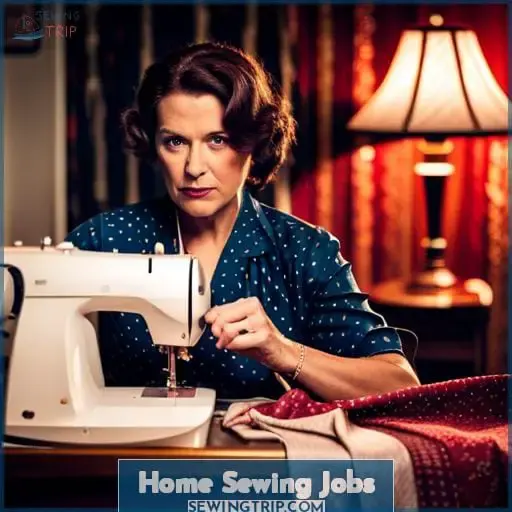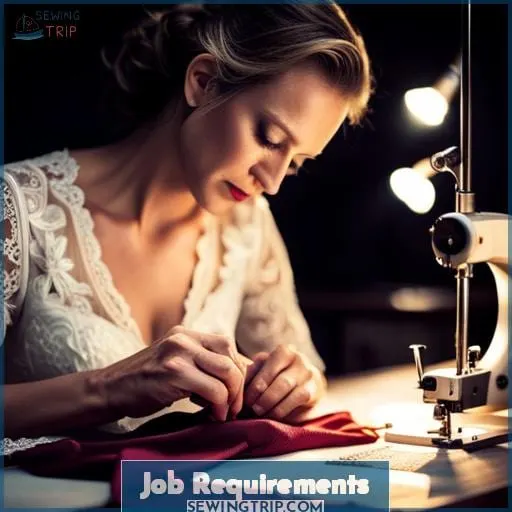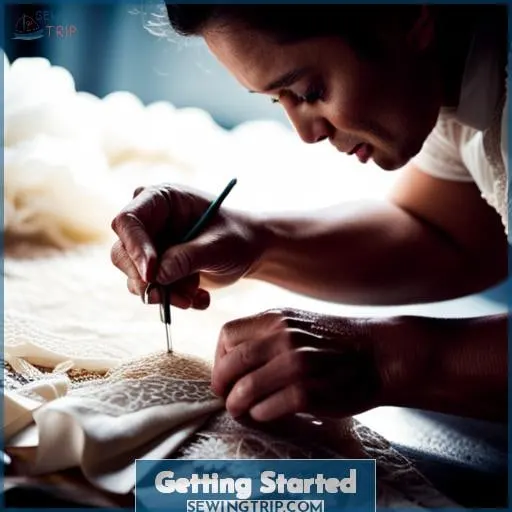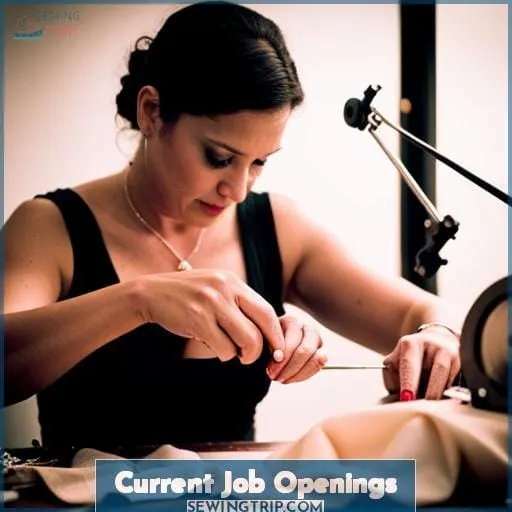This site is supported by our readers. We may earn a commission, at no cost to you, if you purchase through links.
 Hey there! I know you’re looking for more info on sewing jobs. Sewing can be a pretty rewarding career if you have an eye for detail and enjoy working with your hands. The key is finding the right niche, whether it’s fashion design, tailoring, quilting or even sail making.
Hey there! I know you’re looking for more info on sewing jobs. Sewing can be a pretty rewarding career if you have an eye for detail and enjoy working with your hands. The key is finding the right niche, whether it’s fashion design, tailoring, quilting or even sail making.
The average salary for sewing machine operators is around $28,000 per year. Not too shabby! Sure the hours as a seamstress can be long, but there’s nothing quite like seeing your vision come to life in fabric form.
And you’ll always have job security – people will never stop needing clothes tailored and fixed! If you’re crafty and looking for a hands-on career, maybe it’s time to thread up a needle and start stitching.
Table Of Contents
Key Takeaways
- There are niche sewing careers like fashion design, tailoring, quilting, and sailmaking that offer good salaries.
- Jobs in the textile, fashion, and home sewing industries range from material handlers and production workers to buyers, logistics managers, researchers, tailors, and seamstresses.
- Strong skills like machine operation, patternmaking, garment construction, hand stitching, and communication are important for sewing jobs.
- Growing job opportunities in alterations, custom work, and existing sewing positions make this a favorable time to enter the industry.
Textile Industry Jobs
You are responsible for managing raw materials for production as a material handler making about $34,090 a year. As a production worker earning around $35,087 annually, you assemble and maintain manufacturing equipment, while a buyer coordinating purchases and monitoring market trends makes roughly $58,197; then there is the logistics manager who optimizes production processes for approximately $60,694, and finally, a researcher conducting product development research makes about $70,442.
Material Handler
As a material handler, you’ll start at around $34,090 a year managing raw textiles for production.
- Receive and inspect incoming materials
- Organize inventory storage areas
- Maintain quality control standards
- Coordinate materials transfers
- Oversee materials handling personnel
Stay detail-oriented and embrace physical labor to s쳮d in this fast-paced production role. Gaining experience can open doors to higher pay and management opportunities down the line.
Production Worker
Looking at other textile industry jobs, production worker attracts with steady $35,000 income—like your buds you can always grab a beer with on Fridays post-shift. As a production worker, you operate industrial sewing machines for sub-assembly production.
Valuable manufacturing experience sewing fabrics opens doors in production jobs needing sewing skills like operating industrial sewing equipment.
Buyer
Buy merchandise for production by monitoring trends.
- Evaluate supplier offerings to select textiles, trims, and components for production.
- Analyze forecasting data and sales figures to anticipate demand.
- Attend trade shows and runway events to identify emerging fashion trends.
- Negotiate pricing and establish delivery schedules with vendors.
As an influential buyer in the fashion industry, you impact design direction and ensure production has the necessary materials. Remaining cognizant of consumer preferences and style trends is crucial as you make purchasing decisions that position your company for continued success.
Logistics Manager
As a logistics manager, you optimize production and distribution processes. Analyzing supply chain bottlenecks, coordinating vendors, and managing inventory levels, your skills ensure operations run smoothly.
Strategic planning and analysis drive efficiency as you oversee warehouse and transportation operations. Leveraging data and technologies, you implement distribution strategies that support company growth.
Knowledge of logistics principles empowers you to maximize output. You identify and resolve bottlenecks, collaborate with partners, control stock levels, and plan transportation routes. Your analytical mindset and attention to detail enable you to enhance workflows.
By leveraging analytics and emerging technologies, you design and execute solutions that bolster operational performance. Your broad understanding of logistics principles allows you to continuously refine systems and processes to achieve peak efficiency.
With expertise spanning inventory, warehousing, and transportation, you take a systematic approach to maximizing productivity and minimizing costs.
Researcher
Researching new textile methods for product development earns around $70,442 annually.
- Analyzing consumer trends
- Testing fabric innovations
- Developing new sewing techniques
- Creating improved patterns
As a researcher in the sewing industry, you seek out new developments to keep your company at the forefront. Your insatiable curiosity motivates you to constantly examine market trends and perform hands-on experiments.
Through diligent inquiry, you unlock inventive ways to elevate sewing products and practices.
Fashion Industry Jobs
You have an eye for style and a passion for fashion. As a retail merchandiser, retail sales associate, or stylist, you could turn your fashion sense into a career by working directly with apparel and customers.
A job in the fashion industry allows you to indulge your creative side while helping people look and feel their best. Whether it’s keeping store displays on-trend, outfitting clients for special events, or forecasting the next big thing in apparel, there are many exciting career paths for fashion lovers.
With some experience and talent, you can find your dream job in retail management, buying, design, marketing, visual merchandising, fashion writing, or even start your own business. If you’re ready to follow your fashion dreams, the industry offers diverse opportunities to match your skills and interests.
Retail Merchandiser
Consider seriously your foolish dreams of styling store mannequins while reality demands providing useful labor to evade destitution. Beauty hides in clothing’s seams and folds. Raw materials are transformed into garments through needle, thread, and machine.
Display your creations with pride. Window displays attract buyers. Sharp eyes spot imperfections. Adjust the fit for delighted customers. Work is rewarded by seeing elegance emerge from humble cloth.
Retail Sales Associate
As a retail sales associate with $41,899 in income, pour your passion into selling apparel and accessories that reflect your keen fashion sense.
- Develop sales techniques such as upselling, cross-selling, and suggestive selling to increase transactions.
- Provide excellent customer service and product knowledge to create lasting relationships.
- Stay updated on retail trends and fashion to curate an on-trend selection.
- Use visual merchandising to showcase the collection and inspire customers.
Sewing provides the skills to excel as a retail sales associate in the fashion world.
Stylist
Let’s say you stylize clients with your design and fashion savvy. As a stylist, you develop each client’s personal style through wardrobe selection and fashion consulting. You demonstrate your fashion expertise to transform their look. You expand your stylist career by cultivating strong relationships and showcasing your skills.
You want control over their image. But you also want to understand their needs and help them belong in their new style.
| Stylist Strengths | Why Clients Need You |
|---|---|
| Creativity | Lack fashion sense |
| Style knowledge | Need guidance |
| Interpersonal skills | Desire confidence |
Your passion empowers them. Share it through personal touches. Help them stand out while feeling like they belong.
Home Sewing Jobs
Those with excellent hand-eye coordination and experience sewing custom clothing may consider home sewing jobs as a seamstress or tailor. These roles allow for independent work, finding clients through word of mouth or online platforms, to offer specialized sewing services from alteration work to upholstery.
Tailor
After years of perfecting your craft through tailor apprenticeships, you opened your own studio focusing on custom tailoring. Your expert knowledge of tailoring techniques and specialty tailor tools ensures each gown is uniquely fitted to your client’s exact measurements.
As word spreads of your impeccable work, brides rave about the perfect fit of their custom gowns on their special day.
Seamstress
Sally, do your clients value your stylish custom dresses made by hand with your years of commitment and intricate mastery of techniques? As a seamstress entrepreneur, your qualifications in cutting, sewing, and fitting garments delight customers seeking personalized service.
Invest in quality equipment to produce exquisite garments that express your clients’ style. Nurture client relationships through impeccable service and build your reputation in this rewarding career.
Job Requirements
Hello, my dear friend! As a tailor, you need polished sewing skills and strong communication abilities. Specifically, you must have expertise in hand-sewing and operating industrial machines to fulfill client orders with care and expertise.
However, connecting well with customers is also vital to understand their vision and bring it to life through your craft. The role requires expertise in alterations, patternmaking, and garment construction to meet clients’ unique needs.
Strong attention to detail ensures a quality finished product. Interpersonal skills allow you to consult with clients on design, fit, fabric, and budget to bring their apparel ideas to fruition. Tailors must listen closely to transform abstract concepts into wearable pieces.
Clear communication makes collaborating seamless throughout the design process. With advanced sewing talents and personable customer service, you can build a rewarding career crafting custom garments.
Sewing Skills
Having mastery over hand and machine sewing methods is crucial to excelling in home sewing positions, like the Southerland sewing operator role requiring proficiency across various equipment.
- Proficient hand stitching for alterations and embellishments.
- Knowledge of sewing machines – from basic to industrial.
- Experience with varied fabrics – wovens, knits, delicates.
- Patience and precision in every stitch.
Your sewing skills showcase your dedication to quality and craft. Let the fabric guide you as you expertly handle each project. With practice, your talents will continue growing, stitch by stitch. Focus on improving daily, not comparing yourself to others.
Communication Skills
Being sociable with clients fosters rapport and repeat business. Strong communication skills are crucial for sewing jobs to build relationships, provide quality service, and collaborate effectively. An engaging, thoughtful approach shows clients and coworkers you value them. This builds trust and satisfies and retains more customers in the competitive sewing industry.
| Verbal Communication | Nonverbal Communication |
|---|---|
| Clear articulation | Smiling, eye contact |
| Active listening | Open, relaxed body language |
| Friendly small talk | Attentive posture |
| Patient explanations | Nodding along |
| Offering encouragement | Giving full focus |
Getting Started
As someone who sews for a living, I wanted to provide some tips for getting started in this field. The best way is through an apprenticeship or direct application to a sewing business, as these allow you to gain hands-on experience right away.
An apprenticeship provides the opportunity to learn directly from experienced sewers. You’ll be able to ask questions and get feedback as you develop your skills. Reaching out to local sewing shops, fashion design businesses, or even costume and wedding dress makers to inquire about apprenticeship opportunities is a great start.
You could also consider applying directly for a sewing position. Look for job postings from businesses that manufacture clothing, do alterations, make costumes, craft quilts or other textile products. Be sure to highlight any relevant coursework, volunteering, or sewing you’ve done on your own.
A portfolio with examples of your work is also useful during the application process.
With diligent practice, you’ll quickly improve your stitching technique, pattern reading, and garment construction skills. Don’t be afraid to ask questions from mentors and supervisors. Their insights will be invaluable as you gain proficiency.
Maintaining a positive attitude and focus on quality will serve any aspiring sewer well in developing expertise.
Apprenticeship
Since finishing high school, you’ve been leaning toward a career in textiles and could see yourself serving an apprenticeship with an experienced seamstress to learn the ropes.
- Shadow experienced sewers to gain hands-on experience.
- Start with basic hand-sewing techniques before moving to machines.
- Learn about fabrics, patterns, cutting, and finishing.
- Build a portfolio of custom sewing projects.
- Gain insights into running a small sewing business.
Building up your skills through a formal apprenticeship program can provide you with the solid foundations needed to launch your career as a professional seamstress. The hands-on training and industry connections will prove invaluable as you look to establish yourself in this creative field.
Direct Application
You can apply directly for the Sewing Machine Operator job at Southerland, Inc. in Tualatin. As an artisan of fabric, this opportunity offers you a chance to hone your sewing techniques while gaining valuable career experience.
Immerse yourself in an established workplace to build your skills, connect with industry professionals, and position yourself for future advancement. Let your passion for stitching guide you as you bring your talents to an apparel leader committed to nurturing your growth.
Current Job Openings
Darling, let’s talk sewing careers! Right now the job market is hotter than a steam iron. With people sewing more at home, demand for alterations and custom work is through the roof. Small home businesses can’t keep up. Big companies need operators running miles of fabric through their machines.
- Research job listings online and locally.
- Brush up your skills with classes or videos.
- Update your portfolio and business materials.
- Reach out to contractors for temp work.
- Look for apprenticeships with experienced sewers.
This is our time to create something beautiful and find fulfilling work. With some pluck and persistence, you’ll be sewing up success in no time!
Conclusion
So what are you waiting for, seamstress? Get your needle and thread ready to start sewing up success! With the industry’s insatiable appetite for fast fashion, your skills will be in high demand. Just follow the outlined tips here: polish up those stitches, sharpen that eye for detail, and network.
Opportunities exist in alteration shops, manufacturing plants, design houses and beyond. With some ingenuity and pluck, you could even launch your own custom clothing or soft furnishing business.












